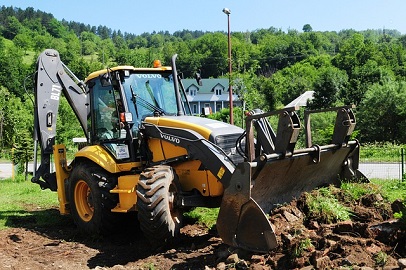Spoil
In the construction industry, the term 'spoil' generally refers to excavated or unwanted material that is removed from the construction site during excavation, earthworks, foundation construction and so on.
Spoil may include soil, rock or other debris that is not useful or necessary for the construction project. It is typically removed from the site and disposed of at a designated facility.
The amount of spoil generated during construction can vary greatly depending on the nature and size of the project, the ground conditions, and the construction methods used. Managing spoil is an important aspect of construction, as improper handling and disposal of spoil can lead to environmental pollution.
In some cases, spoil may be reused or recycled on site, such as by using excavated soil for backfill or landscaping. This can help reduce the amount of material that needs to be disposed of, and may also give cost savings. However, this is not always feasible, in particular in areas where the soil quality is poor or the ground is contaminated.
The amount of spoil generated by the UK construction industry varies from year to year depending on the level of construction activity and the nature of the projects being undertaken. According to data from the UK government's Waste Data Flow report for 2019, the construction, demolition, and excavation sector generated a total of 59.4 million tonnes of waste, of which 29.3 million tonnes was excavated waste, including spoil. The report notes that the majority of excavated waste is disposed of in landfill sites, although some of it is reused or recycled, primarily for land restoration or landscaping purposes.
It's worth noting that the UK construction industry has set targets for reducing waste and improving sustainability, including through the use of more efficient construction methods, reducing the use of virgin materials, and increasing the reuse and recycling of construction waste, including spoil. This reflects a growing awareness of the environmental impact of construction activities and a desire to improve the sustainability of the industry as a whole.
[edit] Related articles on Designing Buildings
Featured articles and news
Amendment to the GB Energy Bill welcomed by ECA
Move prevents nationally-owned energy company from investing in solar panels produced by modern slavery.
Gregor Harvie argues that AI is state-sanctioned theft of IP.
Heat pumps, vehicle chargers and heating appliances must be sold with smart functionality.
Experimental AI housing target help for councils
Experimental AI could help councils meet housing targets by digitising records.
New-style degrees set for reformed ARB accreditation
Following the ARB Tomorrow's Architects competency outcomes for Architects.
BSRIA Occupant Wellbeing survey BOW
Occupant satisfaction and wellbeing tool inc. physical environment, indoor facilities, functionality and accessibility.
Preserving, waterproofing and decorating buildings.
Many resources for visitors aswell as new features for members.
Using technology to empower communities
The Community data platform; capturing the DNA of a place and fostering participation, for better design.
Heat pump and wind turbine sound calculations for PDRs
MCS publish updated sound calculation standards for permitted development installations.
Homes England creates largest housing-led site in the North
Successful, 34 hectare land acquisition with the residential allocation now completed.
Scottish apprenticeship training proposals
General support although better accountability and transparency is sought.
The history of building regulations
A story of belated action in response to crisis.
Moisture, fire safety and emerging trends in living walls
How wet is your wall?
Current policy explained and newly published consultation by the UK and Welsh Governments.
British architecture 1919–39. Book review.
Conservation of listed prefabs in Moseley.
Energy industry calls for urgent reform.


























Comments
[edit] To make a comment about this article, or to suggest changes, click 'Add a comment' above. Separate your comments from any existing comments by inserting a horizontal line.